About Daruma doll
What is daruma doll?
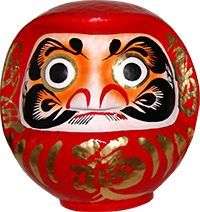 Daruma is a traditional handmade wishing doll made in Japan.
Daruma is a traditional handmade wishing doll made in Japan.And it is the most popular good luck charm in Japan.
Much of the daruma is purchased in the market, which opens around January.
The buyers take it home and put it hoping to be happy for a year.
It is also common that companies buy dolls for prosperous business, or election offices buy them to win elections.
Then in the next year, someone keep their daruma, but someone dedicate it to temple or shrine and buy a new daruma again.
Of course, daruma dolls are sold all year round, so anyone can buy them at the store.
Daruma dolls are now widely purchased around the world besides for personal use, such as birthday present, wedding present, souvenir of the completion of Japanese martial arts, and mascot of ceremonies or events.
Design and features
Daruma symbolizes meditation of Bodhidharma - Founder of Zen Buddhism.
The rounded shape also shows tenacity that if it fall down seven times, get up eight. (actual dolls do not have this behavior.)
Daruma is made of paper mache. and red is the traditional color.
The rounded shape also shows tenacity that if it fall down seven times, get up eight. (actual dolls do not have this behavior.)
Daruma is made of paper mache. and red is the traditional color.
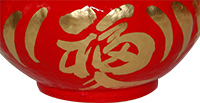 On the bottom of daruma the letter Fukuiri is written.
On the bottom of daruma the letter Fukuiri is written.
That means here is happiness in it.
This design is also called Fuku daruma or Fukuiri daruma.
For large size dolls, this part can be freely rewritten with an optional order.
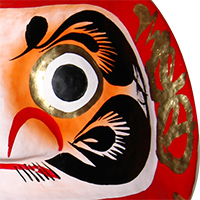 The eyebrows represent a crane and the beard represents a turtle's tail.
The eyebrows represent a crane and the beard represents a turtle's tail.
In Japan, as a proverb it is said that cranes live 1000 years and turtles live 10000 years, and they have been used in design since ancient times as a symbol of celebration.
For large size dolls, in the part corresponding to the ear, wishes are written such as family safety, fulfillment of wishes, and prosperous business.
How to make a wish
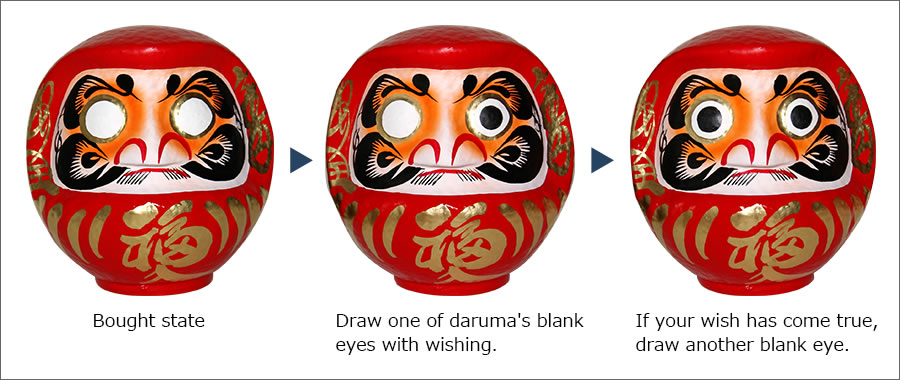 Making a wish is easy, just put one eye on the daruma.
Making a wish is easy, just put one eye on the daruma.First of all, think about the purpose such as family happiness or prosperous business.
Then draw one of daruma's blank eyes in black with your wishes.
This work does not have to be rigorous one like having a strong feeling of wishing results.
Instead, it's a common practice to be excited and casual.
It's just like winding a missanga or buying a lottery ticket.
Decoration examples
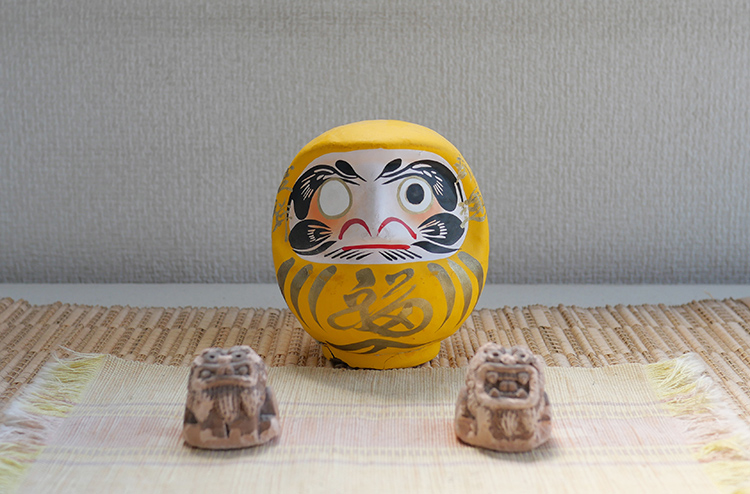
at home (size 2)
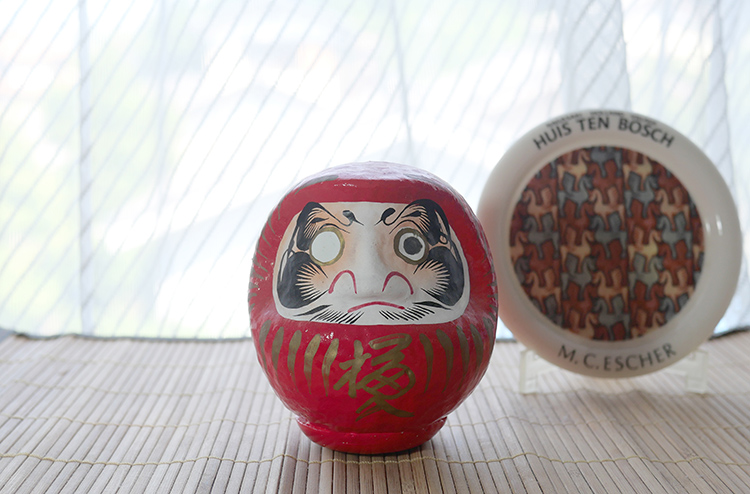
at home (size 2)
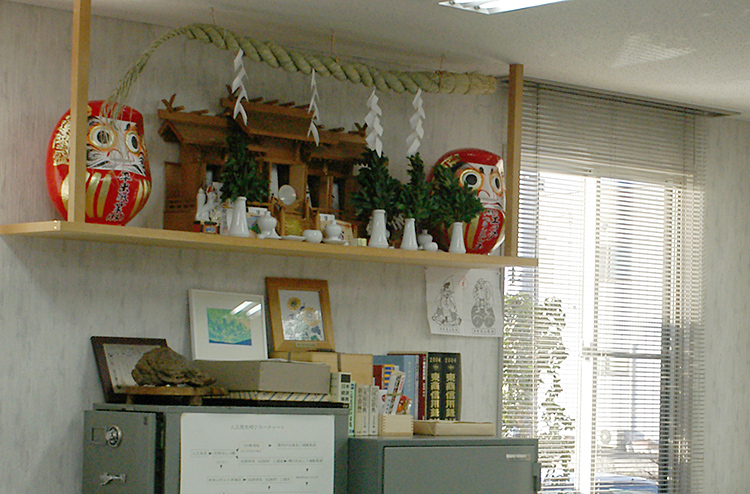
at office
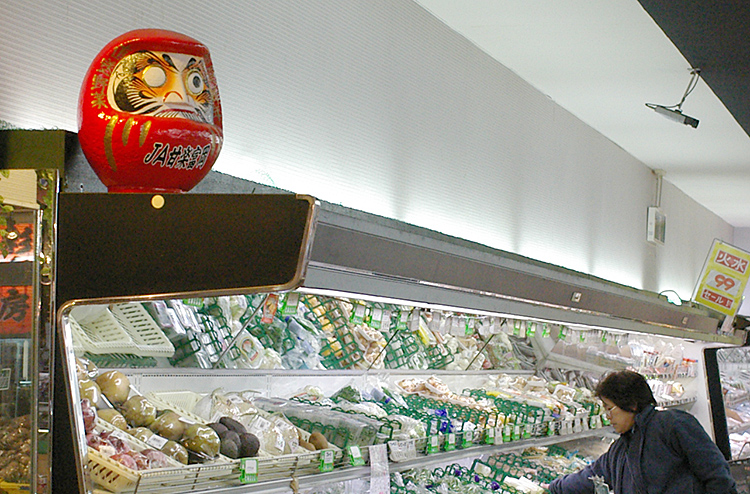
at supermarket
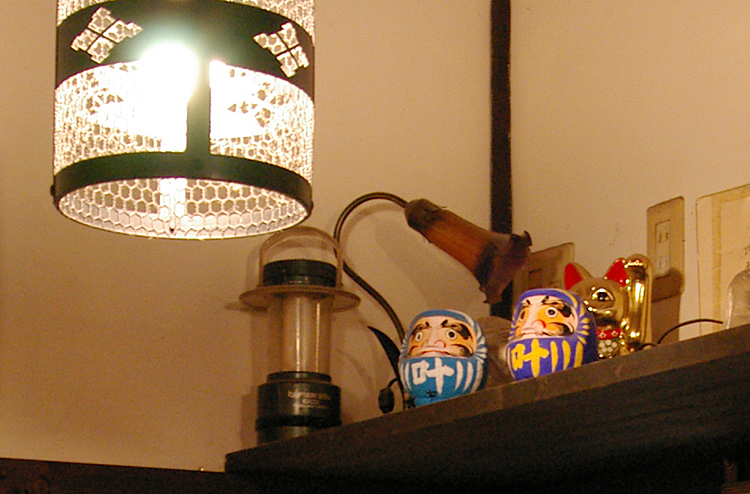
at restaurant
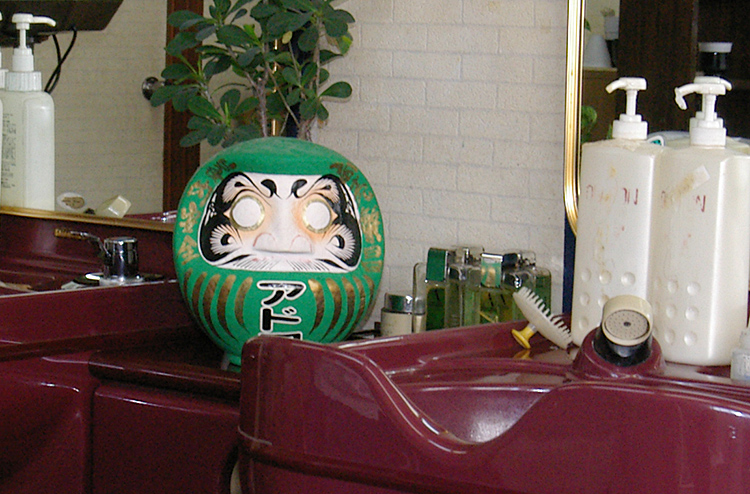
at barber shop
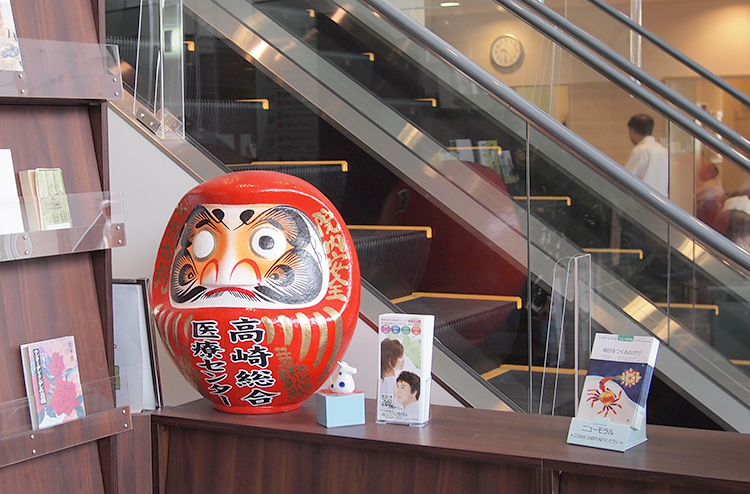
at hospital
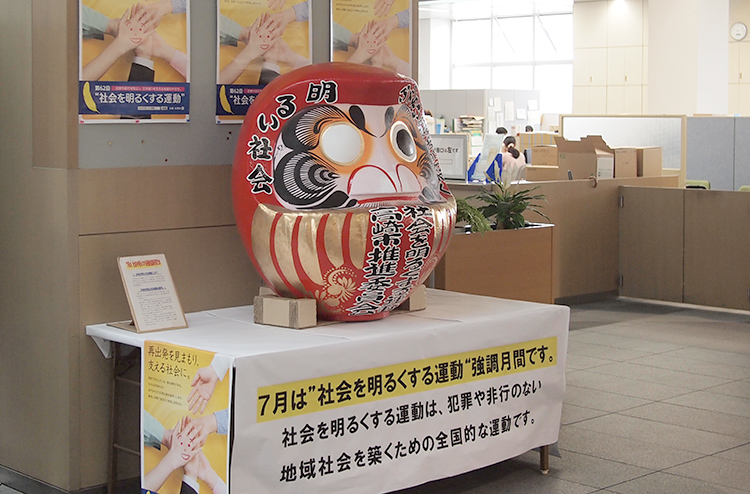
at city hall
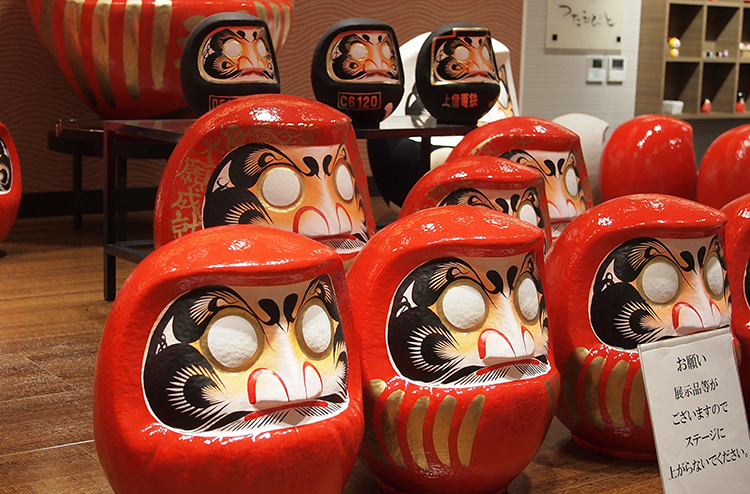
at souvenir shop
History of Daruma doll
In about the 5th century,at the cave of South China, Bodhidharma - Founder of Zen Buddhism - enlightened at the end of Zazen - sitting not to speak toward a wall - for nine years.
There is a legend that he lost his limbs by performing Zazen, and derived from this, Daruma dolls were made in the shape without limbs.
On the other hand, the origin of Daruma lies in the doll "Futouou - bùdǎowēng", it gets up even if it knock down by putting an earth weight near the rounded bottom to lower the center of gravity.
This was handed down to Japan during the 14-16th century, and "Okiagari-koboshi" were created.
It is presumed that Daruma like today was born in the 18th century, and that Daruma's Zazen figure was copied to a Okiagari-koboshi it would rise even if he fell down, and it is speculated that it had an indomitable feeling.
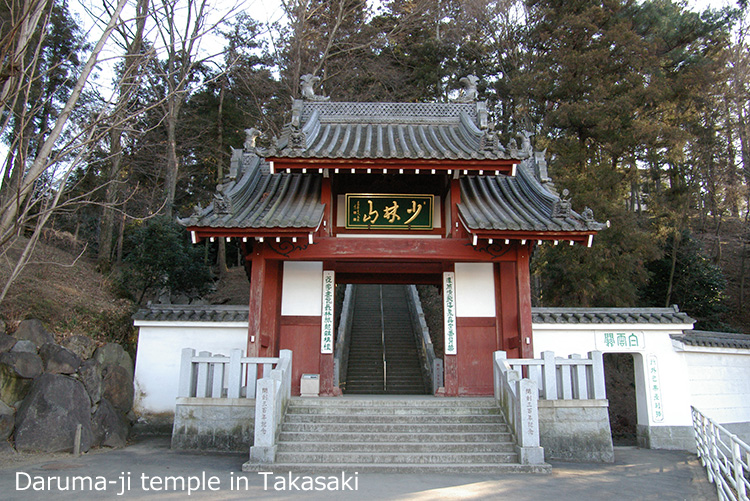 In 1667, Zen Master Shinetsu built a Daruma-ji temple at Mt.Shorinzan in Takasaki.
In 1667, Zen Master Shinetsu built a Daruma-ji temple at Mt.Shorinzan in Takasaki.
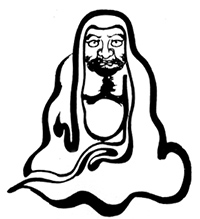 He drew a Zen meditation image of Bodhidharma.
He drew a Zen meditation image of Bodhidharma.
It came to be distributed at new year's days, and it is assumed that it is a start of the Takasaki Daruma.
In other words, it is the origin of Japanese Daruma.
Afterwards in the 19th century, Tomogoro Yamagata made an initial Daruma doll putting Japanese papers on a wooden mold carved by Priest Togaku.
In the 19th century (Meiji period), the sericulture industry flourished, Daruma dolls were asked by those who prayed to harvest a lot of silk.
And in the present age, Daruma doll became indispensable as a target prayed for the business prosperity.
There is a legend that he lost his limbs by performing Zazen, and derived from this, Daruma dolls were made in the shape without limbs.
On the other hand, the origin of Daruma lies in the doll "Futouou - bùdǎowēng", it gets up even if it knock down by putting an earth weight near the rounded bottom to lower the center of gravity.
This was handed down to Japan during the 14-16th century, and "Okiagari-koboshi" were created.
It is presumed that Daruma like today was born in the 18th century, and that Daruma's Zazen figure was copied to a Okiagari-koboshi it would rise even if he fell down, and it is speculated that it had an indomitable feeling.
 In 1667, Zen Master Shinetsu built a Daruma-ji temple at Mt.Shorinzan in Takasaki.
In 1667, Zen Master Shinetsu built a Daruma-ji temple at Mt.Shorinzan in Takasaki.
 He drew a Zen meditation image of Bodhidharma.
He drew a Zen meditation image of Bodhidharma.It came to be distributed at new year's days, and it is assumed that it is a start of the Takasaki Daruma.
In other words, it is the origin of Japanese Daruma.
Afterwards in the 19th century, Tomogoro Yamagata made an initial Daruma doll putting Japanese papers on a wooden mold carved by Priest Togaku.
In the 19th century (Meiji period), the sericulture industry flourished, Daruma dolls were asked by those who prayed to harvest a lot of silk.
And in the present age, Daruma doll became indispensable as a target prayed for the business prosperity.
Takasaki Daruma
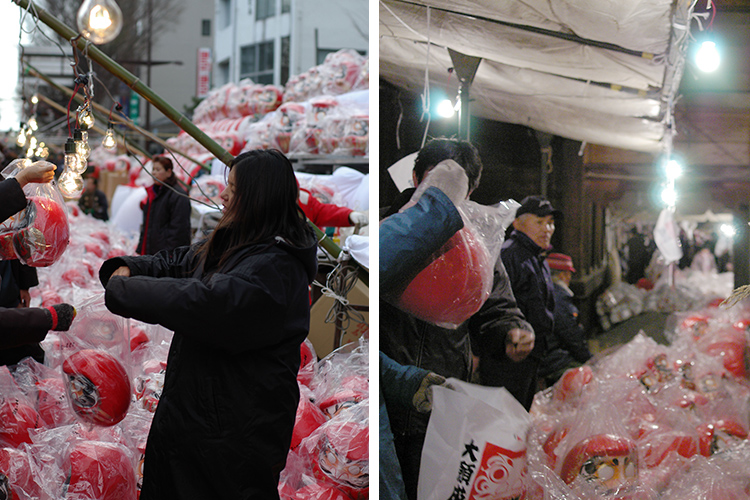
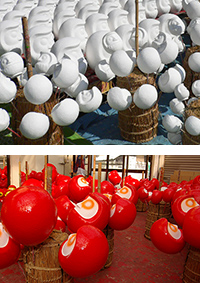 In Japan, about 80% of Daruma dolls are made in Takasaki City.
In Japan, about 80% of Daruma dolls are made in Takasaki City.Takasaki City is a local city in Gunma Prefecture located almost at the center of Japan.
Sericulture was an active here for a long time.
There is a Daruma-ji temple at the Mt.Shorinzan in Takasaki City, and the fair is held on January.
It crowds with many people who buy the Daruma doll from all over Japan.
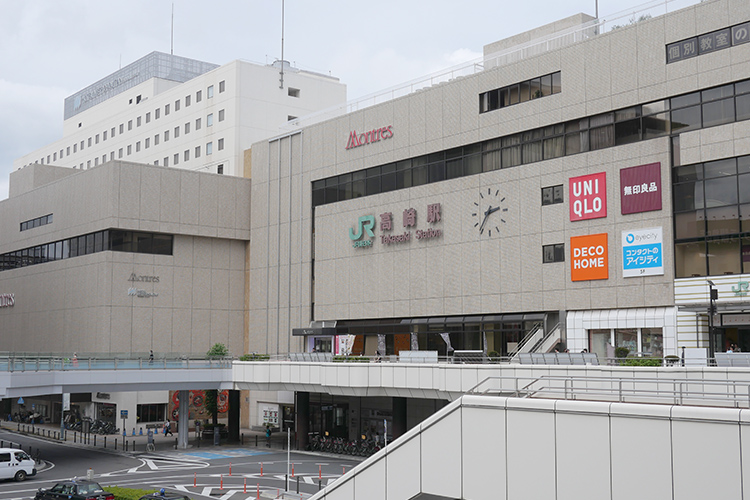
Takasaki station
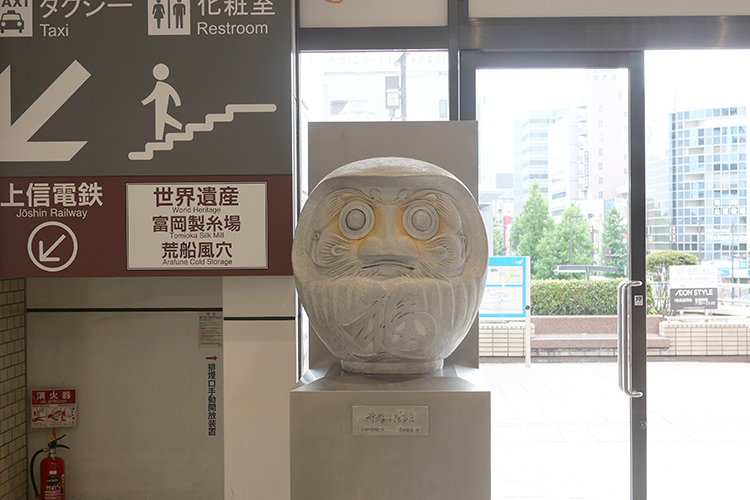
Takasaki station
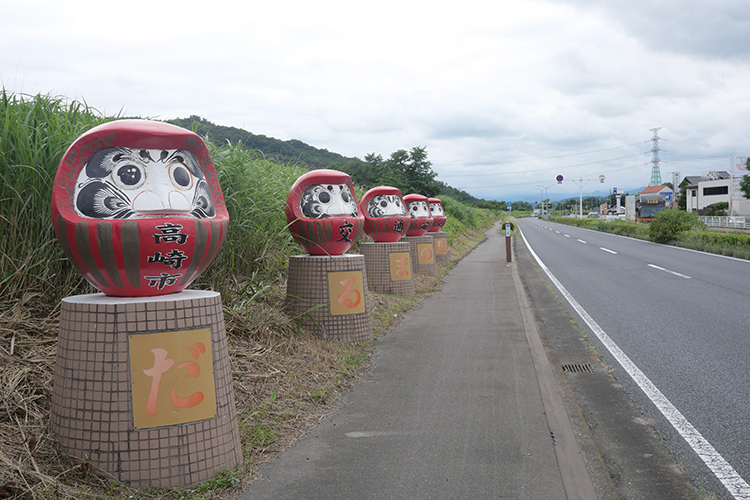
Factory area
FAQ
What are color meanings of Daruma dolls?
Today, in addition to traditional red, there are many different colors of Daruma dolls.
These are recently released, and the meaning given to each color varies depending on the store.
Actually, each color does not have a deep meaning, so you can choose your favorite color.
For reference, the colors and their meaning are:
These are recently released, and the meaning given to each color varies depending on the store.
Actually, each color does not have a deep meaning, so you can choose your favorite color.
For reference, the colors and their meaning are:
- Red : luck and good fortune
- Pink : love and attracts romance and passion
- Orange : pregnancy and safety
- Yellow : financial good fortune
- Green : physical health
- Black : success in business ventures
- Purple : health and longevity
- Blue : success in school and the development of the intellect
- Gold : wealth and prosperity
- White : love and harmony
Why does Daruma doll have one eye?
The eyes of Daruma doll are blank when sold as a means to keep track of goals or big tasks and motivate them to work to the finish.
The recipient of the doll fills in one eye upon setting the goal, then the other upon fulfilling it.
In this way, every time they see the one-eyed Daruma, they recall the goal.
One explanation how this custom started says that in order to motivate Daruma-san to grant your wish, you promise to give him full sight once the goal is accomplished.
This practice might also have something to do with the "enlightenment", the ideal attainment of Buddhism.
Referring to "opening" the second eye, it expresses the realization of a goal.
The recipient of the doll fills in one eye upon setting the goal, then the other upon fulfilling it.
In this way, every time they see the one-eyed Daruma, they recall the goal.
One explanation how this custom started says that in order to motivate Daruma-san to grant your wish, you promise to give him full sight once the goal is accomplished.
This practice might also have something to do with the "enlightenment", the ideal attainment of Buddhism.
Referring to "opening" the second eye, it expresses the realization of a goal.
Which eye do you fill in first on a Daruma doll?
Many sources say that you should color the left eye first.
The left eye means the doll’s left eye, not the eye that is on your left as you face him.
However, there is no correct order of painting eyes of a Daruma doll.
This is written on the site of Gunma Daruma Doll Manufacturers’Cooperative Union in the birthplace of Takasaki Daruma doll.
Drawing eyes signifies “opening of a Daruma doll’s mind’s eye”, not just filling in the blank eyes.
The left eye means the doll’s left eye, not the eye that is on your left as you face him.
However, there is no correct order of painting eyes of a Daruma doll.
This is written on the site of Gunma Daruma Doll Manufacturers’Cooperative Union in the birthplace of Takasaki Daruma doll.
Drawing eyes signifies “opening of a Daruma doll’s mind’s eye”, not just filling in the blank eyes.
What are Daruma dolls made out of?
Daruma dolls are usually made of recycled paper - papier-mâché.
Papier-mache literally "chewed paper", "pulped paper", or "mashed paper" is a composite material consisting of paper pieces or pulp, sometimes reinforced with textiles, bound with an adhesive, such as glue, starch, or wallpaper paste.
The base of Darurma doll is completed by placing the mold in a tank of paper melted, sucking out the moisture with a compressor, taking it out when it hardens, and drying it in the sun.
Papier-mache literally "chewed paper", "pulped paper", or "mashed paper" is a composite material consisting of paper pieces or pulp, sometimes reinforced with textiles, bound with an adhesive, such as glue, starch, or wallpaper paste.
The base of Darurma doll is completed by placing the mold in a tank of paper melted, sucking out the moisture with a compressor, taking it out when it hardens, and drying it in the sun.
What are Japanese good luck charms?
In addition to Daruma, there are some good luck charms in Japan.
- Maneki Neko
The Maneki Neko is a cat figurine believed to bring good luck. Typically, one or both paws are raised. They are often called “waving cats” in English because of the position of the paw, but in Japan, this gesture, with the palm facing down, is used to beckon someone toward you. Because of their gestures, Maneki Neko is often valued by store owners as amulets to attract customers. - Omamori
Omamori is a protective amulet that people can buy from shrines. The talisman is wrapped up in a brocade bag, and it’s considered bad luck to open it and peek inside. There are omamori meant as a general good luck charm, while others are very specific. There are charms for good grades, good fortune in business or love, and even for a healthy pregnancy and delivery. - Omikuji
Omikuji is a strip of paper containing good or bad predictions. They are available at shrines and temples in return for a small donation. If the fortune is good, you keep it and hang on to your luck. If the prophecy is bad, you tie the strip up on a wire or branch at the shrine and leave the bad luck behind you. - Ema
Ema is common sight at many shrines. They are small wooden plaques that people write their dreams and wishes on as a public declaration. These wooden plaques are eventually burned in ceremonial fires at the shrines. - Koinobori
Koinobori is a carp streamer. They are a traditional decoration for Children’s Day, a national holiday that occurs in May each year. These windsocks are symbol of good luck and represent the family’s wishes to have happy, healthy and successful children. - Osechi ryori
Osechi ryori are traditional foods eaten around New Year’s in Japan. Many of these foods are meant to bring luck in the new year for a certain aspect of life. For example, those wishing for children eat kazunoko or marinated herring roe, while those praying for good health eat soybeans. - Senbazuru
Senbazuru are strings of 1,000 origami cranes - typically 25 strings, each with 40 cranes. It’s believed that completing all 1,000 of them will grant the owner a wish. Senbazuru have become a symbol of healing and hope.
